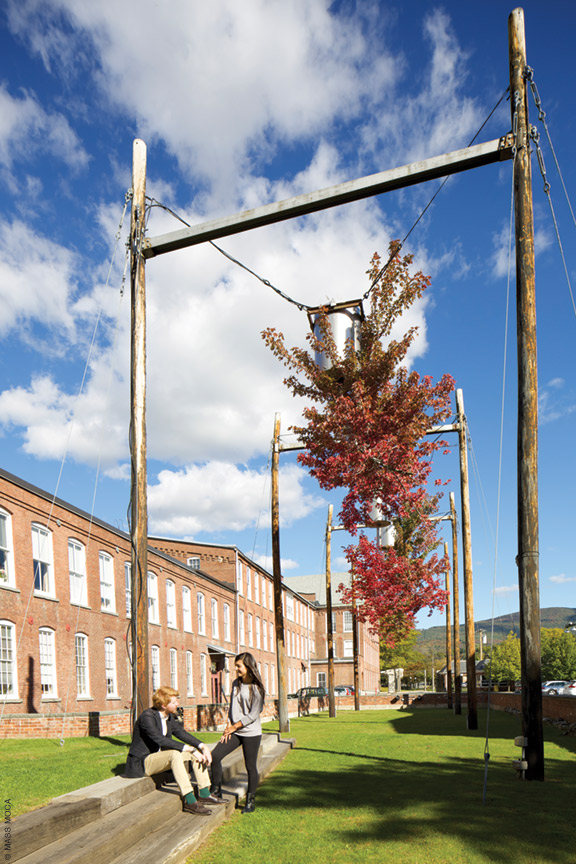
Joseph Thompson on building the country’s unlikeliest art museum.
He’s flown his Grumman Tiger from western Massachusetts to the Burning Man festival in the Nevada desert, and he’s sweated it out, in altogether different fashion, as a roughneck “pushing pipe” in the oil fields of his native Oklahoma. But the derring-do of Joseph Thompson WG’87 likely reached its apogee when he assumed the helm of a then-nascent museum in 1988. In the ensuing 33 years, Thompson helped create MASS MoCA, now billed as the world’s largest museum of contemporary art.
Sprawled across a campus containing more than 500,000 square feet of interior space, half of which is devoted to exhibitions, MASS MoCA is a place of exposed brick and unfinished plaster. It’s a place where immersive artists like Nick Cave and Cai Guo-Qiang have installed large-scale, site-specific works in galleries that stretch hundreds of feet. It’s also a place that the 62-year-old Thompson describes as “all I’ve lived, done, and thought about for more than three decades. The first was trying to build it, the second making sure it survived, and the third getting it into great shape.”
And now, Thompson has wrangled with the realization that it might be time to leave. “I’ve begun to feel like that person who says, No, we’ve done that already or We tried that and it didn’t work,” he observes. “There are whole new generations of staff who have wonderful ideas. It’s their turn.”
The story of Thompson and MASS MoCA goes back to the early 1980s. After graduating from Williams College in Williamstown, Massachusetts, he spent a few years bouncing around those Oklahoma oil fields, and then the world, before accepting an offer to come to work with one of his art professors, Thomas Krens, who had been appointed as the director of the college’s newly renovated and expanded art museum. When Krens returned from an art festival in Germany, his enthusiastic descriptions of the raw, makeshift galleries he’d seen—minimally retrofitted garages and crumbling churches—got the two thinking. “We had been turning away a lot of artists who wanted to knock down walls and rip up carpets,” Thompson laughs. “So we were, like, ‘Let’s go find an abandoned warehouse and open up a satellite wing of the Williams museum.’ I was just 26 years old. Tom was only 10 years older. Hubris got the better of us.”
They visited a few small factory buildings in the area before stumbling upon the 1870s Arnold textile mill in the neighboring town of North Adams, Massachusetts. “It was so beautiful,” Thompson says of the massive complex, which knits together more than two dozen buildings with a pleasing array of covered bridges and courtyards. “From the outside, it looked like a hulking red brick fortress. But inside it was full of sunlight and huge open spaces with trusses. The textures of the wooden floors and the exposed masonry had a romantic feel—the amplitude and generosity of space was jaw-dropping,” he continues. “But the idea of using it as a museum was pretty radical at a time when there was a museological fascism that said galleries had to be hermetically sealed, climate-controlled, and with no outside light.”
Just five miles from the Clark Art Institute, and not far from other cultural attractions like the Norman Rockwell Museum and the Tanglewood and Jacob’s Pillow performance venues, the location also held the promise of looping struggling North Adams into the richness of the Berkshires. “At the time, North Adams had the highest unemployment, highest illiteracy rate, most teenage pregnancies, you name it, in the state,” Thompson points out. The mayor was sold and Governor Michael Dukakis came around once Thompson wrote an economic impact statement, “using those skills I sharpened at Wharton,” he says. “We didn’t lead our case with the art; we wanted to change the future and feeling of North Adams.” Eventually, the complex would far exceed his predictions, drawing almost 200,000 visitors a year.
When Krens was offered the opportunity to run New York’s Guggenheim Museum, he suggested Thompson join him. “But I wanted to stay,” Thompson says, “and make MASS MoCA happen.” But fortune had other plans and the project derailed.
“Dukakis went off and ran for president, but his campaign collapsed and so did the Massachusetts economy,” Thompson recalls. “1989 and ’90 were brutal years and everything associated with Dukakis suddenly had a negative side. No exaggeration, there were about 150 editorials along the lines of ‘What the heck is the state thinking of in supporting this crazy effort when we can’t pay teachers and roads can’t be paved?’”
So Thompson devoted himself to nonstop fundraising and lobbyingefforts. For 11 years.

MASS MoCA finally opened to the public in 1999. Since then, it’s turned into not just an art museum, but a performing arts center with a packed schedule that brings in a diversity of visitors who might never have come otherwise. MASS MoCA has also populated parts of its complex with commercial tenants, ranging from a brewery to professional offices; acquired a few other parcels around town; and even built a boutique hotel across the street. “When I think back on my career,” Thompson says, “it’s been as much about real estate development as anything.”
Perhaps most significant, MASS MoCA has embarked on a series of phased expansions, rehabbing varied spaces every few years and turning them over to the long-term display of work by artists like Sol LeWitt, Jenny Holzer, and James Turrell. “These pieces are like the great lodestones,” Thompson says. “They give us all the benefits of a permanent collection—every time you come back, they’re here—without the burdens.”
With the institution finally in a good place, Thompson will bow out by the end of this summer. The pandemic forced him to lay off or furlough about 75 percent of MASS MoCA’s employees, but most have returned and the museum reopened in July 2020.
Not surprisingly, it continues to be hard to leave. “This place feels like home,” he says. “I’m just starting to think about where I go from here. I’m letting my mind wander. I like commercial real estate development, I love biking, I love flying. I’m not going to work in another museum, but Tom [Krens] has been floating the idea of a new model railroad-meets-architecture museum. We’ve talked about it a lot. It’s a 100,000-square-foot, $60 million, highly speculative venture in North Adams. People love miniatures and movement, and interweaving that with the vast terrain of 200 great buildings, of Fallingwater next to the Empire State Building next to…” his voice trails off.
“I don’t know if I want to bite off something like that again,” he says. “But doesn’t it sound fabulous beyond belief?”
—JoAnn Greco

